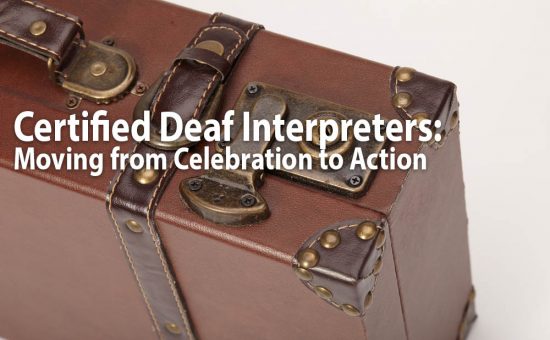Sign Language Interpreting: The Benefits of Think Aloud Protocols
Marty Taylor presented Sign Language Interpreting: The Benefits of Think Aloud Protocols at StreetLeverage – Live 2016 | Fremont. Her presentation discusses how focusing on process can result in more effective and nuanced interpretations.
You can find the PPT deck for her presentation here.
[Note from StreetLeverage: What follows is an English translation of Marty’s StreetLeverage – Live 2016 presentation. We would encourage each of you to watch the video and access Marty’s original presentation directly.]
If you enjoy this presentation and accompanying article, consider going to StreetLeverage – Live.
Sign Language Interpreting: The Benefits of Think Aloud Protocols
My topic today is “Sign Language Interpreting: The Benefits of Think Aloud Protocols.” Think Aloud Protocols, abbreviated as T.A.P., refer to the process of talking about thinking. This is a commonly researched topic for discovering how people think and identifying qualitative and quantitative data. Think Aloud Protocols (T.A.P.) have been studied regularly since the 1960s with increasing frequency. We need to apply the data from this research to sign language interpreting and to our work as practitioners. In addition to applying the research, we can also apply T.A.P. directly to our work. That is what I’d like to talk about with you today.
Think Aloud Protocols as a System
First, let’s talk about protocols. When we talk about protocols, we are looking at a system – something that can be replicated and shared with other sign language interpreters. They represent ways we can discuss and debate our thought processes. The establishment and use of a system allow us to take our interpreting work to a more advanced level.
Usually, when we talk about Think Aloud Protocols (T.A.P.), we are talking about a simultaneous process. While a person is performing their work – regardless of the type of task – they talk about or sign about their work. As sign language interpreters, it would be impossible to talk about what we are doing while simultaneously interpreting. There is no way to do that. If a person is translating from a written text, it would be possible to talk about the translation process. So there is also what is called, “Think After Protocol” which is much like “Think Aloud Protocols.” They are similar processes. For “Think After Protocols,” an interpreter would perform the work and once they had completed the task, they could look back on their work through self-analysis, asking, “What did I do? What could I do next time? How can I apply this learning to the future?”
It is important to have a system rather than a random method of looking at our work. Instead of having endless approaches, T.A.P. focus on specific ways to examine our thinking, the meanings behind those thinking processes, and the reasons for making each decision. These protocols help us to gather information about the whole process. This is what we are looking for in the T.A.P. experience.
Thinking about Thinking
We often hear the terms “cognitive thinking process” and “metacognition” which is thinking about thinking. So, thinking about thinking. We can do that. What we are doing with T.A.P. is taking our thinking and talking about it. Sharing information, learning, and teaching other people about our process.
Each individual has their particular way of thinking. There is no “right” or “wrong” answer in this case. There is simply process. Some people process information in a structured, methodical way. My thinking process is not like that. My thoughts typically meander from point to point. I will eventually get to the main topic, but my thoughts usually take a circuitous route. As a nonlinear thinker, I’m fascinated by a linear thinker’s process. How do they accomplish such structured thinking? It’s almost like meditation. And again, everyone is different. We all think differently. While I may be thinking about children, babies, interpreting, life and world travel, you all may be thinking about StreetLeverage – Live, about interpreting, about going to work tomorrow. You may be thinking, “I hope the presenters today are interesting or I’m out of here!” Today, you have to think about which workshops you will attend in the afternoon. Hopefully, you are clear that the four speakers will present their longer workshops twice in the afternoon. The workshops are an hour and a half each and we present them twice. This means you can select two presenters and attend their workshops – mine and one other. So, you may be thinking that one workshop isn’t interesting to you, but you know you can select two of the others. Unfortunately, you can’t attend them all.
The point is that we each think differently. This is an important thing. The diversity of thinking benefits us. I can learn how you think, what you think about, how you feel, how you express yourself, the topics you discuss. For example, a person might talk about animals or their love of photography, or their interest in baseball. You may know that I live in Canada and that I am a proud Canadian.
The Venditte Rule
A rule means that a new situation has emerged and thought is given to examine, discuss, and decide how to proceed in this new situation. In baseball – Do you like sports? Some of you may be thinking, “I am so not going to that workshop this afternoon if Marty Taylor is going to talk about sports!” That’s perfectly all right. Back to the “Venditte Rule.” As you may know, some batters are more proficient batting left or right. That’s a fairly common occurrence. A pitcher who can pitch proficiently with either arm is not common at all.
The “Venditte Rule” requires the pitcher to declare to the batter which hand he will use before each pitch. Every time. This allows the batter to decide whether to bat left- or right-handed. Clearly, you can see my prowess on the baseball field by my stance here on the stage. That is the “Venditte Rule.” The pitcher can change their approach every pitch and the batter can switch batting sides, as well. This illustrates a different way of thinking. So, Canada has one baseball team for the entire country as compared to the numerous teams in the United States. We also have an ambidextrous pitcher who is equally proficient pitching with either arm, striking players out with regularity. As an aside, in baseball, a strike is represented by a K. Two strikes is KK and three strikes is represented as KKK. This is just an FYI for everyone. This is the truth. They don’t use XXX for strikes in baseball. Just sharing my T.A.P. knowledge with you. I’m keeping you all informed and now you know about baseball’s special rule.
Focus on the Process
There have been numerous people who have researched Think Aloud Protocols (T.A.P.) related to a variety of topics. In our field of interpreting and translating, for both spoken language and signed language interpreting, there is some research available. Not a lot, but there is some. For example, Debbie Russell, Betsy Winston, and Jemina Napier have all done some research. I’ve borrowed from their work, as well as research from other disciplines, whether it be research on children, mathematics, geography, technology, computers, etc. In the vast body of research these disciplines represent, a common theme emerged, indicating that the most experienced, the leaders and top practitioners in these disciplines, all model and focus on process. They focus on the process of doing the work at least 75% of the time. The remaining 25% of the time is focused on product. It is interesting to note that we typically think about the product – the thing we produce, the things we can see, the result of our work. So, for our purposes, T.A.P. encourages us to focus on process.
Looking Deeper
It seems that research in the field of interpreting and translating, whether spoken or signed languages are involved, has come to similar conclusions cited above. If a sign language interpreter is able to utilize more advanced thinking skills or thinks more deeply, their interpretation is going to be more successful. That’s pretty obvious. So, when I say “deeper”, you might be wondering what I mean. I’ll give you a few examples.
- When a sign language interpreter considers the speaker’s intent, they are able to focus on the deeper meanings within the message. If they consider the speaker’s purpose, they will ultimately produce a more effective interpretation.
- Consider audience/participant needs. We have to look at the makeup of the audience – who is present? Are they Deaf or hearing? Is the audience comprised of U.S. residents or are there some Canadians in the audience? Today, we at least have one Canadian present, maybe more. I don’t know – I haven’t seen anyone yet. So, considering audience make-up is important.
- Finally, the interpreting process has to be considered.
If we can incorporate these three considerations in our process – speaker’s intent, audience needs and preferences, and the interpreting process itself, we typically see a more advanced, more successful work product. By including these three aspects, we are able to demonstrate our experience and our level of proficiency as compared to novice or less experienced interpreters.
Knowledge Lean vs. Knowledge Rich Skills
If we look at “knowledge lean skills” versus “knowledge rich skills”, we can see that “knowledge lean skills” represent more simple meanings. For example, an interpreter who is focused on vocabulary, grammar, sentence structure/syntax, will provide a more limited, superficial interpretation. This is focusing on product. This knowledge lean view may also include some language “challenges” that the interpreter must work through and resolve.
In contrast, “Knowledge Rich Skills” focus on process, deeper meaning, and context. We consider all the participants involved, the purpose of the communication. We also look at the interpreter’s purpose – why are they there? Are they doing a good job? All these things are part of the process. Again, if we are looking at process 75% of the time, we are good to go. I’m sure you are all spending 75% of your time looking at process. I’m sure you are all doing just fine.
“Knowledge Rich Skills” also examines social interactions. Most commonly, we see Deaf individuals in isolation. If we think about a Deaf child who is mainstreamed – they are usually isolated. Where is that social interaction for them? Where do they get social exposure to develop relationships? If we look at situations involving Deaf adults, even if the purpose of a meeting is informational, there is still a social component to it. It is so important to consider those deeper meanings and pieces of information in order to use these “knowledge rich” skills.
Interpreters are more sensitive and aware of social cues. In recognizing the emotional tenor of participants, sign language interpreters can incorporate that information in their process, not just staying on the more surface-level product.
Think Process
Regardless of our status as introverts or extroverts, our goal is to think about the system, the process of interpreting. In this afternoon’s workshops, I will expand on T.A.P. in more detail. For now, consider this: Think Aloud Protocols can benefit our interpreting practice. Think hard. Think wisely. Think process.
Hand waves to you all!











